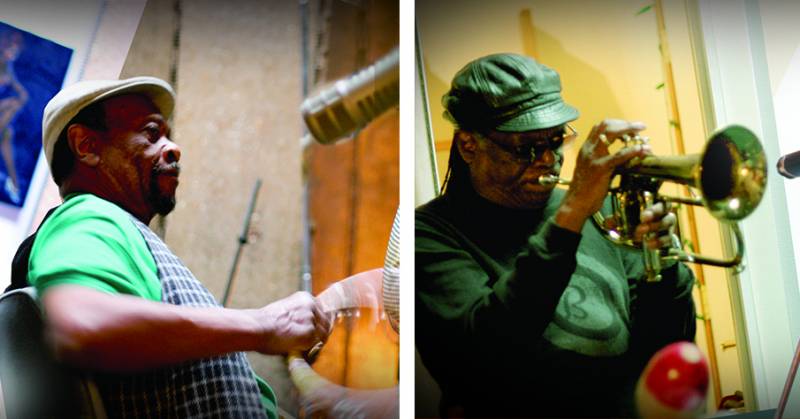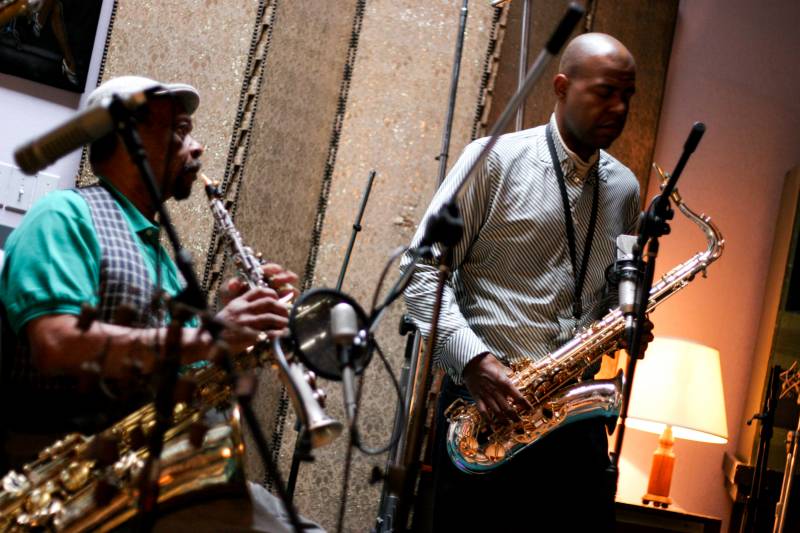
A posthumous release from Eddie Gale (right) and Prince Lasha (left) adds a new chapter to the discographies of two artists who helped radically expand jazz’s sonic frontiers in the 1960s. (Paul Waters)
Sauntering into San Francisco’s Closer Studios in a bright green suit with a bag full of horns slung over his shoulder, Prince Lasha didn’t need to play a note to make a lasting impression. Nearly a dozen years after his final recording session, the saxophonist, flutist, clarinetist and largely unsung avant-garde jazz patriarch hasn’t faded a bit from the memory of fellow Oakland multi-instrumentalist Howard Wiley. The fact that Lasha (pronounced La-shay) was also accompanied by a female college student—who may or may not have been researching a paper about him, and was carrying a gun—added considerable drama to his entrance.
“He came packing,” recalls Wiley, who was part of a contingent of younger players on a session organized by producer Eric Moffat. “It was some otherworldly type of thing, but we had a great time. He was a beautiful cat who wanted everyone to contribute to the session and be free.”
Convened on an overcast fall day just weeks before the 2008 election, the long-rumored recording has just surfaced as 6X6, a new album that arrives as the music world mourns last month’s loss of San Jose-based trumpeter Eddie Gale, another under-recorded jazz master coaxed into the studio that day by Moffat. The project not only adds a new chapter to the discographies of two artists who helped radically expand jazz’s sonic frontiers in the 1960s, it highlights the Bay Area’s underground history of harboring groundbreaking under-the-radar improvisers.
A New York native, Gale earned early acclaim for his work embracing the form-expanding, rhythmically unfettered, tonally adventurous music of pianists Sun Ra and Cecil Taylor. Even after he went on to record two acclaimed Black consciousness albums for Blue Note, 1968’s Ghetto Music and 1969’s Black Rhythm Happening, he maintained close ties with Ra, the singular bandleader and Afro-futurist composer and poet whose music projected Black culture into the cosmos.
“Until he left the planet, I was with Sun Ra,” Gale told me in a 2002 interview. “He had a special place for me in the Arkestra, and whenever he came to California he’d call and say, ‘Come and play.’ I stayed in touch with Cecil Taylor too. He’s an Aries, fire, and I’m a Leo, fire, and all the cats in his band were stretching. I learned a lot of things from Cecil. How to structure your ideas, how to write them out.”
Gale came to the Bay Area in 1972 for an artist-in-residence stint at Stanford University. After the semester, he ended up settling with his family in San Jose. He spent a lot of his time bringing music education programs into schools around the region, and for two decades produced an annual concert in San Jose for world peace that attracted musicians representing numerous styles and traditions.
“When I first settled out here people kept saying to me, ‘You should be up in San Francisco, that’s where the jazz scene is,’” Gale said. “I’d say, ‘There’s a highway that takes me right up there, and to Oakland and Berkeley too.’ I’m involved in stuff all over the Bay Area, but some of the most rewarding work has been in the schools, opening up doors for young people to express themselves.”
Lasha was one of players drawn into Gale’s orbit, performing often in the trumpeter’s band from the 1990s on. He was part of an extraordinary cadre of Black musicians from Fort Worth, Texas, and he spent his formative years performing alongside fellow I.M. Terrell High School students such as clarinetist John Carter, alto saxophonist Ornette Coleman, drummer Charles Moffett and saxophonists Dewey Redman and King Curtis. They were all steeped in blues and gut-bucket R&B. But except for Curtis, who earned fame for his work on R&B, soul and rock ‘n’ roll hits, Lasha’s classmates became leading figures in the movement often called free jazz.

Like Coleman, Lasha moved to Los Angeles for several years in the 1950s, a period when he also spent some time in San Francisco. He made his mark with a series of classic albums, starting with his 1962 Contemporary release The Cry! which featured his luscious flute work and the scorching alto sax of Sonny Simmons (another under-sung jazz explorer who spent many years in the Bay Area). In 1970, his Firebirds band with Simmons, Fort Worth drummer Charles Moffett and vibraphonist Bobby Hutcherson played a series of riveting concerts in California, recording live albums at the Monterey Jazz Festival and the Berkeley Jazz Festival. Lasha ended up moving to Oakland and started investing in real estate, living in a house behind the Claremont Hotel with his wife and nine kids.
He hadn’t been recording much when Eric Moffat brought him and Gale into the studio session that turned out to be his valedictory statement. “He passed away early December and it was a shock,” Moffat says. “His playing was so strong during that session. He’s a badass and he brought it.”
Oakland-reared drummer Darrell Green, a close musical confidant of Howard Wiley now based in New York City, provided the pulse, and Broun Fellinis’ tenor saxophonist David Boyce served as a generational and stylistic bridge between the rising East Bay contingent and the avant-garde lions. At the center of the action was bassist Marcus Shelby. Playing in the trumpeter’s band at the time, he connected Moffat with Gale and Lasha.
Each of the six musicians contributed a tune, hence the album’s title 6X6. With the election only days away, a sense of optimism filled the room. Gale kicked off the session with a blazing piece that’s part chant and part joyous conflagration, “This is for Obama.” Moffat recalls that Gale introduced a horn riff and then kept increasing the tempo. “They finally hit this rhythm, and did that song in one take,” he says. “Prince just turned the temperature way up and everyone rose to it. They played that for over 10 minutes and I thought we were done for the day. Where are you going to go after this? But we got five more great songs.”
Lasha took the reins on the next number, a baritone sax-powered Ellingtonian ballad called “Birds Brilliant Colors.” Shelby followed with a lovely piece inspired by his daughter, “Kennedy’s African Playground.” As thrilled as he was to be recording with two pioneering masters, Shelby recalls that it was Boyce’s presence at the session that made it special for him.
“One of the reasons I had moved up to San Francisco was because I had seen groups like Broun Fellinis,” says Shelby, who first gained national attention with the Los Angeles hard-bop band Black/Note, which recorded for Impulse! and Columbia. “Black/Note had just broken up and I needed to go somewhere I could grow. David Boyce was playing a totally different style than what I was doing, but I liked the music and the energy and fell in love with that band. I loved what he did and how he and Howard worked together. It’s not a style I’m associated with, but it was one of my favorite sessions I’ve ever done.”